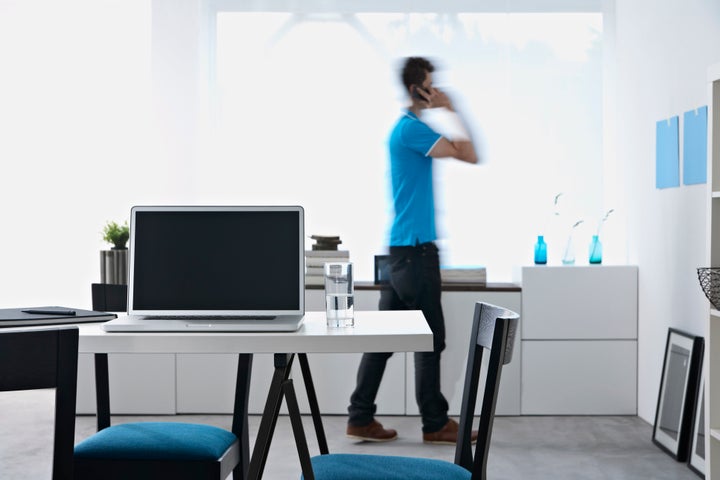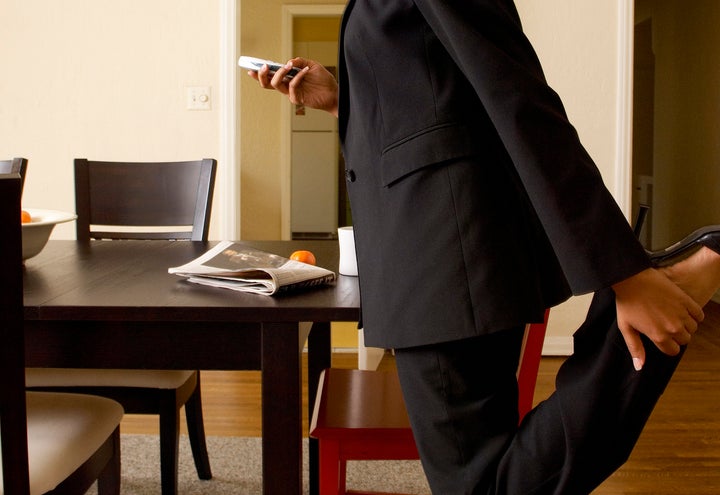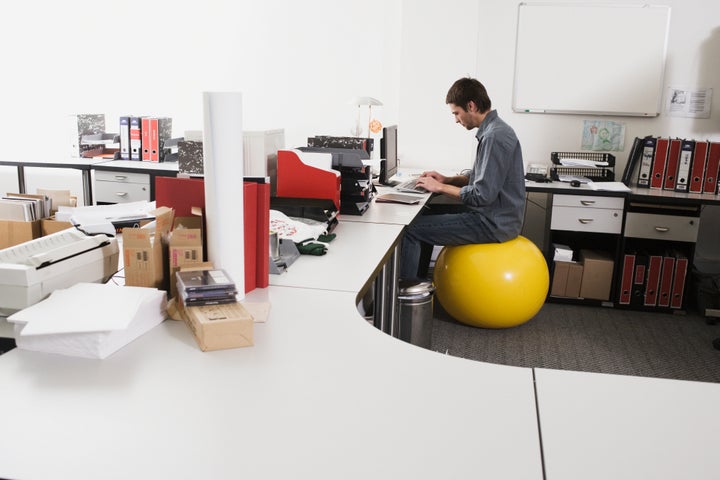
We know sitting down all day in the same position is bad for our health. Even back in the 1950s researchers found London bus drivers were twice as likely to have heart attacks as their bus conductor colleagues. Today, prompted by our increasingly screen-based sedentary lifestyles, there has been an explosion of research into quite how bad sitting for long stretches of time is for you. Not only does sitting at work all day slow the metabolism (so affecting our ability to regulate blood sugar and blood pressure and metabolise fat) but staying in the same position for hours on end also weakens our muscles, causing debilitating aches and pains, particularly back, neck and RSI problems in our hands and wrists.
Professor Stuart Biddle, chair of a government-commissioned report into our sedentary lifestyles, summed up the alarming facts: “Essentially, the body is ‘shutting down’ while sitting and there is little muscle activity.”
Shockingly, a survey last year by the British Heart Foundation charity of 2,000 office workers found that 45% of women and 37% of men spend less than 30 minutes a day on their feet at work and more than half regularly eat their lunch at their desk, rather than taking a break from their screens to clear their head, move their muscles and de-stress in the open air.

Sammy Margo, a chartered physiotherapist, says: “Our bodies are designed to move little and often, not sit at a desk for prolonged periods. We’re becoming physically underactive”.
Even worse is when you consider many of us switch our eight hours at a desk, neck locked onto the screen, shoulders hunched and hand tensed over the mouse, for an evening spent slumped in front of the TV or PlayStation.
So, with an always-on work culture, how can you incorporate exercise into your working day to alleviate and relieve aches and pains?
During the working day
Your goal is to ease tension and use different muscles by breaking the cycle of arriving at work and sitting down in the exact same position for the eight or more hours. Aim to break up desk time with shorter bouts of activity for just one to two minutes and with stretches and exercise you can even do at your desk (see below).
Set a reminder to get up every 30 minutes and take “an active break from sitting”, as recommended by the Department of Health commissioned Sedentary Behaviour and Obesity Expert Working Group.
Get up and move for a few minutes whilst rotating your shoulders and neck to ease muscle tension.
Avoid repetitive strain injury (RSI) and other upper limb aches and pains by taking regular breaks from the same position. Rotate your wrists clockwise then anticlockwise to ease muscle tension. Rotate your head slowly and gently to ease strain.
Swap your office chair for a stability ball to work your abdominal muscles and improve your core strength.

Walk and talk when you make and take phone calls. It’s called a mobile - you should be too.
Stand at meetings - take turns standing on one leg at a time. Many offices now offer workers standing desks to reduce back strain so it’s worth asking your HR department.
Take a walk to a colleague’s desk rather than hammering out another email and make sure you take your tea breaks.
When you do suffer from back ache, a painfully stiff neck or RSI, the best course of action is to stay active - tempting as it may be, taking to your bed it’s not the best way to recover. Over the counter pain relief gels, such as Voltarol Pain-eze Emulgel, may help too. Voltarol provides up to three times more effective pain relief vs non-medicated gels. Its triple effect relieves pain at source, reduces inflammation and helps speed up recovery. If back pain persists for more than six weeks, consult a doctor.

Simple exercises to reduce tension and muscle stress
Physiotherapist Sammy Margo suggests these everyday stretching exercises you can incorporate into your working day to ease aches and pains.
Sit stretches
“Long periods of sitting with your knees and hips flexed can cause the muscles at the back of your legs - your hamstrings - to shorten and become tight. This stretch will address that problem,” says Sammy.
1. Perch on the edge of your seat and stretch your right leg out in front of you. Rest your heel on the floor with your foot pointing up.
2. Lean forward slightly from your hips and look straight ahead. You should feel a gentle stretch but no pain along the back of your right leg.
3. Hold the stretch for 20 seconds, repeat three times and then swap legs.
Leg-ups
“Spending too much time sitting can make the muscles on the front of your thighs (quadriceps) tight. Over time, this can leave you at greater risk of injury to your knees and lower back,” says Sammy. The following exercise will stretch out your quads.
1. Stand in front of your desk and place your left hand on it for balance.
2. Standing on your left leg, raise your right heel towards your right buttock. Grab hold of your right foot with your right hand. You should feel a stretch along the front of your thigh.
3. Hold the stretch for 20 seconds, repeat three times and then switch legs.

Are you sitting properly?
Good posture is important for keeping your back, neck and other joints healthy. Try to break the habit of slouching at your desk.
Sit with your bottom right at the back of your seat and rest against the back of your chair for support to your lower back.
Rest your forearms on your desk with your elbows at a 90o angle.
Relax your shoulders, don’t allow them to elevate or round.
Make sure both of your feet are flat on the floor, and your knees are level with your hips, to avoid knee strain.
Imagine there is a piece of string coming through your body and out of the top of your head to the ceiling. This will prevent slumping and help keep you upright.
Place your screen at eye level to avoid neck tensions - too low and you’ll have to bend your neck, too high and you’ll be in a constant stretched position. Don’t hunch over a laptop screen. Either raise it on a pile of books at eye level or ask your employer for a full screen monitor.
Keep your mouse close and your keyboard at a distance of four to six inches, which allows your wrists to rest on the desk between typing.
Voltarol Pain-eze Emulgel contains diclofenac diethylammonium for pain and inflammation. Always read the label.
Sammy Margo does not endorse any products or brands
Voltarol is a trademark owned by or licensed to the GSK group of companies